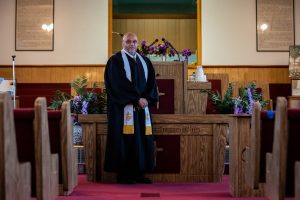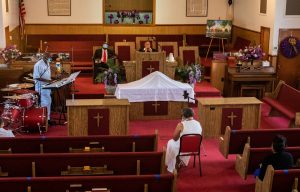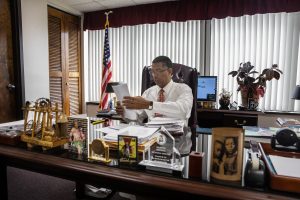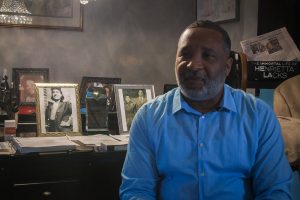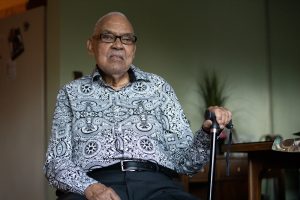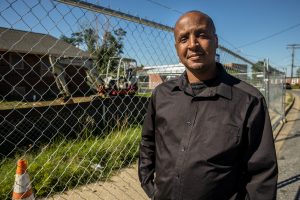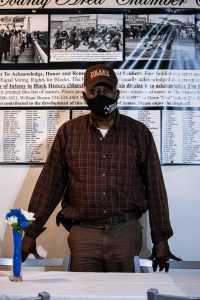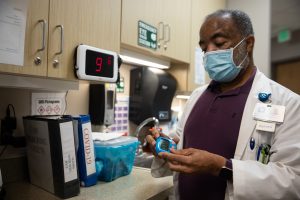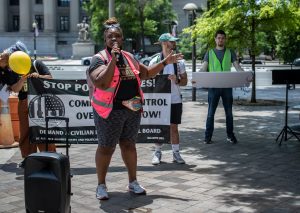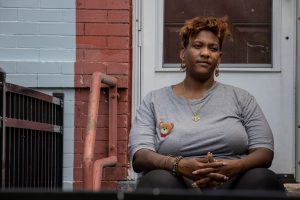- Slug: BC-CNS Black Americans Hesitancy, 3,190 words.
- 12 photos and captions below.
- 2 videos here and here.
By Amudalat Ajasa, Amanda Paule and Ian S. Brundige
News21
By late June, Yolanda Corbett, a single mother of three living in Washington, D.C., was certain she would not get the COVID-19 vaccine. She wanted to protect her family more than anything, and although the vaccine was a clear sign of hope for many, Corbett wasn’t convinced.
“All of a sudden a country that has literally kept a foot on our necks for years, and even during a pandemic has shown that it has no interest in collectively supporting us as human beings or as a people of color, to put my life and my family’s lives in your hands, to trust that you want to suddenly give me a vaccine that’s going to save us,” Corbett said.
“Like, am I willing to gamble that they care this time?”
Corbett’s resolve was rooted in historic mistreatment of Black Americans by the U.S. government and medical institutions, whether it was Henrietta Lacks’ stolen cells or the altered lives of hundreds of Black men in Tuskegee, who were left untreated for syphilis in the name of research.
The centuries of mistreatment that have infused distrust in Black communities impact health, said Gail Christopher, executive director of the National Collaborative for Health Equity.
“All of that shows up in our bodies – there’s just no way it doesn’t,” Christopher said. “And then you had this being hit by a Mack truck in terms of this COVID-19 pandemic, so of course you had disproportionate impact and outcomes.”
Since the start of the pandemic in the U.S. in March 2020, Black Americans have borne the brunt of the virus. The Centers for Disease Control and Prevention report that Black Americans are twice as likely to die from COVID-19 compared to their white counterparts. In the nation’s capital, while Black Americans make up 45% of the population, they account for 76% of the COVID-19 deaths, according to D.C. government data.
“The essence of the disproportionate impact of COVID-19 had to do with preexisting conditions and excess exposure because of the economic inequity,” Christopher said.
Black leaders in churches, in barbershops and beauty salons, and on the airwaves – leaders who have earned the trust of their communities – have become key to vaccinating a wary population.
What is unclear, longtime activists and advocates say, is whether the systemic racism that was magnified by the pandemic – overrepresentation in poverty, underrepresentation in wealth, lack of access to housing and transportation – will remain.
By August, 71% of Black D.C. residents had not been fully vaccinated, according to district data.
Opportunity gap: ‘My wallet doesn’t match up with my intellect’
The gated unit in D.C.’s 5th Ward was once Corbett’s hope for stability, but now it’s a source of anxiety.
The neighborhood doesn’t compare to the Southeast D.C. community where she grew up. But the red-painted brick townhome is at least a roof over her family’s head – an improvement from their previous rental, where the ceiling caved in on them.
But as the pandemic started, she was about to be evicted. The nationwide moratorium temporarily spared her family.
Her current reality of applying for food stamps and relying on community members to provide food for her and her children is far from the future she would’ve chosen while majoring in psychology at Talladega College in Alabama.
“At the end of the day, my wallet doesn’t match up with my intellect,” she said. “That part is the part that always weighs me down … It’s not for lack of drive or ideas, it’s for lack of access. And that part, for a person who likes to control their own destiny, is the most frustrating part.”
Corbett’s experience exemplifies a preexisting housing crisis in D.C. and the rest of the nation. Zillah Wesley, a co-chair of the Poor People’s Campaign, estimates that affording a two-bedroom apartment in the city, without utilities, requires an income of more than $33 an hour.
But with a minimum wage of $15.20 an hour, many Black D.C. residents can’t afford housing, as rent rates increase faster than working-class incomes, according to the D.C. Fiscal Policy Institute. In D.C. more than 1 in every 5 Black people live below the poverty line.
“We’re always told, ‘Just pull yourself up by your bootstraps, you’ll make it work,’” Wesley said. “But a lot of people don’t even have boots.”
The nation’s capital is a microcosm of the inequity playing out in communities across the country. Christopher, of the health equity collaborative, argues that social determinants – such as access to employment, transportation, food and safe neighborhoods – are largely responsible for a community’s health.
Rather than focus on health care, which emphasizes treatment, Christopher argues that the government should invest in systems that prevent poor health, like housing.
“We have a policy for housing that is driven by a profiteering real estate industry,” Christopher said. “That is one issue that I think we must address, because housing and health go hand in hand.”
Poverty’s cycle: The fight to ‘survive or thrive’
The slow-paced, porch-culture community of Lowndes County, Alabama, spans more than 700 square miles. It has 10,000 residents, one physician and no hospital. It also experienced one of the highest COVID-19 infection rates in the state, according to data from the U.S. Department of Health and Human Services.
George Thomas, the county’s only doctor, laments the systematic lack of access in a county that is 75% Black and where 1 in every 3 Black residents live below the poverty line.
“It’s not just endemic in Lowndes County, it’s all the counties, because all of them are facing pretty much the same issues,” Thomas said. “And basically it’s poverty. With poverty, you don’t have access to certain things that you need to survive or thrive.”
Thomas and several other public health and community officials in Lowndes, Montgomery and Macon Counties cited Alabama’s failure to expand its Medicaid program as a major reason for COVID-19’s disproportionate impact on its poorer residents.
The restrictions mean an estimated 324,000 of Alabama’s residents who would otherwise be covered are uninsured and therefore unable to access primary and preventive care services, according to a study by the Urban Institute.
And rural hospitals face a closure crisis. Over the past decade, an average of 12 rural hospitals have closed each year, often due to unexpanded Medicaid leading to large portions of local patients being unable to afford hospital services, according to the Chartis Center for Rural Health.
“You need primary care, you need preventive care, when you’re dealing with chronic disease,” Christopher said. “And remember, it was the chronic diseases, the obesity, the diabetes, the heart disease, the kidney disease, the asthma, cancer, which are all, again, disproportionately experienced by African Americans.”
Ozelle Hubert, who lives in Clarke County, worked for decades as a pharmacist in Lowndes and before that in Cook County, Illinois. He said he sees the same health care access issues in Lowndes as he saw in Chicago.
“When you’re in urban areas, where you have poverty, where you have projects, health care disparity, it’s no different, in my opinion, than it is in the rural areas,” Hubert said. “It means a lack of access or lack of quality care.”
Hubert commutes two hours to Lowndes to consult with county officials on economic development and health care. Now president and chief executive officer of the newly established Lowndes County Chamber of Commerce, he wants a hospital in a county that has never had one.
“So when we do have a pandemic like this (in the future) … guess what? We can take care of our residents,” Hubert said.
In a county that has only one ambulance and where most residents live at least 25 miles from the nearest emergency room, it’s a mission that’s been on his mind for at least six years. He finally received a letter of support from the county commissioner this year.
Lack of access to health care is not always about proximity to the nearest clinic. An hour and a half away in Tuskegee, Alabama, the city contracted with a new ambulance service and average response times have dropped from 55 minutes to 15, according to Tuskegee Mayor Lawrence Haygood Jr. He said for emergencies, a helicopter flies patients to a regional hospital that would typically be 40 minutes away by car.
“So don’t put in your mind this is bad to live here because there’s not a hospital right here,” Haygood said. “The key is how soon do you get to quality care and how soon can you get into the hospital? … It’s just a difference in perception.”
Medical mistreatment: ‘Their humanity was not recognized’
Generational trauma over medical mistreatment and malpractice manifests itself in vaccine hesitation, which has proven deadly for Black Americans.
“Trauma stunts your DNA to the point where it could create a pathology, a way of thinking, that is damaging to you being the best version of yourself,” said David Hodge, associate director of education at Tuskegee University Bioethics Center. He said that due to persistent historical and institutional harm, Black people’s DNA has been altered to make decisions that will spare them from further trauma.
Among the most notorious cases is the U.S. Public Health Service Syphilis Study in Tuskegee, where public health officials, for 40 years, watched nearly 400 Black men succumb slowly to syphilis-related illness. Another 201 men were used as control subjects. In Baltimore, 809 miles away and two decades after the experiment in Tuskegee began, white doctors in a segregated hospital ward extracted tissue samples from a Black woman named Henrietta Lacks and used them without her consent.
“The issue of trust is what has been tarnished,” said Omar Neal, 64, who was born in the same building while the study was being conducted. “Trust is a calculated risk. And so you have to have a basis for trusting.”
From 1932 to 1972, the syphilis study, based at what was then known as the Tuskegee Institute, recruited poor Black men who had been infected with syphilis with promises of free food, free burials and treatment for their “bad blood.”
“You may not know the details of what happened with the syphilis study – most people don’t. But you know something happened,” Hodge said.
The men never received treatment. Instead, year after year, they were brought back, studied, and sent back home to their wives.
In 1943, a decade after the study started, penicillin was discovered as a cure. The men never got the drug.
“When we think about it from the vantage point of the length of time that it took place, it just spoke to the inhumanity that was heaped upon those men – their humanity was not recognized,” Neal said as he sat on the steps outside of the building where he was born.
Another discovery, as a teenager, stunned him. His uncle Freddie Lee Tyson was a survivor of the syphilis study. But Tyson rarely talked about it.
The hospital has since been closed, but the original dark-red bricks still distinguish the building and its dark history from the rest of Tuskegee University’s Center for Bioethics.
In Baltimore, 20 years after the syphilis study in Tuskegee started, Johns Hopkins researchers in the tissues laboratory didn’t talk to Lacks or her family about using her cells.
Lacks died in 1951, months after she was diagnosed with cervical cancer, but her self-replicating cells made her immortal. Her cells, known as HeLa cells, were instrumental in creating a vaccine for polio and enabling research on sexually transmitted infections and cancer, among other biological research efforts.
Veronica Robinson said her great-grandmother’s cells were stolen. Medical corporations and science have profited from Lacks’ cells, she said.
“The rich got richer and the Lacks family was forgotten about,” Robinson said. “You see these industries, these CEOs, and they are driving these great cars and things. And we as a family still pull together to try to get a Lacks member through college.”
Jeffrey Kahn, who has been in the bioethics department at John Hopkins for more than a decade, said that it wasn’t uncommon for the cell samples of patients to be taken before consent and intellectual property rights rules were updated at the end of the 20th century. He also said Lacks wasn’t racially targeted.
Lacks’ descendants waited nearly a decade for a lawyer to take their case against pharmaceutical companies, said Alfred Lacks-Carter Jr., the founder and president of the Henrietta Lacks House of Healing. In August, the family hired Ben Crump, a prominent civil rights lawyer, to represent them.
“As Black people, we’ve been stripped of so much, and to be stripped of your own story and your own legacy is very disheartening,” said Lacks-Carter Jr., the grandson of Henrietta Lacks. He hopes to hold pharmaceutical companies legally accountable and compel them to compensate his family.
The legacy has seeped into vaccine hesitation in the Black community.
“People of color have been disproportionately affected by this virus, and because of the history of racism in this country, a larger percentage of people of color have kind of been leery about the vaccine,” said George Jones, chief executive of the food pantry and assistance agency Bread for the City in D.C.
Black leaders are working to combat that hesitation head-on.
Black leaders: ‘We want to protect our community’
A line of masked Black women wearing bonnets and headscarves laced with warm reds and oranges sit inside Juanita’s Salon and Spa in Tuskegee. Beauticians snip hair and rinse relaxers from scalps.
Disinfecting spray, wipes and masks top the front desk. Juanita Magruder, who has owned the salon for 20 years, always eases her clients into the conversation about the vaccine.
“I think it’s very important that we educate our clients, because they are so close to us,” Magruder said. “And if we gain a really good rapport with our clients, I feel like they will listen to us, and we can encourage them to get their shots, their vaccines.”
Juanita’s is among more than 20 shops in the area that are part of the White House initiative Shots at the Shops, which aims to encourage vaccinations in the community through trusted messengers.
Magruder estimates that 99% of her 50 clients have gotten the vaccine. It’s different in the rest of Macon County.
As of Aug. 1, about 32% of county residents are fully vaccinated. Alabama ranks dead last in the U.S. in vaccination rates, with about one-third of the population fully vaccinated, compared to nearly half of the country. No Alabama county has more than 40% of its population fully vaccinated.
Community leaders and public officials are stepping up efforts in the pulpit and on air.
“We do want to let you know that the delta virus is increasing throughout the United States. And it’s a very strong variant of the COVID-19. So we want to remind everybody that’s why we’ve got to be particularly cautious and safe,” said Haygood, the mayor, his message squeezed between gospel songs and quizzes about the Bible on WUBZ radio, which reaches a national audience.
Haygood, who joined two former mayors who were vaccinated on television and social media, also works with Tuskegee’s COVID-19 task force, which has been meeting every Saturday since the pandemic started.
On Sundays, religious leaders thread Scripture with talk of the virus and the vaccine.
“In most Black communities here in the rural South, the church is pretty much the center of activity, (and) pretty much the epicenter, if you will, of information sharing and so forth,” said Bishop Aaron McCall of the First Missionary Baptist Church in Hayneville, Alabama. “When the pastor says, ‘Let’s go get vaccinated’ or the pastors themselves start getting vaccinated … people at large in the community tend to follow suit.”
As masked churchgoers walk into Bethel Missionary Baptist Church, past the wall-mounted hand sanitizer and blue surgical masks, sometimes they hug, and other times they exchange pleasantries from an uncustomary distance.
The church, filled with about 20 members stationed at their tape-marked spots in the pews, hangs on the words of Pastor Kenneth Jones.
“We want to do all we can in order to protect our community,” Jones tells his in-person congregation and to his livestreaming audience. “So please sir, please ma’am, just make sure you let everybody know it ain’t over.”
The worshippers listen and look up at the pastor on the podium as they cool themselves with handheld fans.
Jones launches into a passionate homily relating mask wearing to teachings about making sacrifices for the greater good. Scattered whoops and amens erupt from the small crowd in the red pews.
“By him telling his members … to get vaccinated, it probably pushed them to think more about how it can keep their families safe, them safe and their community safe,” Sasha Clark, 19, said after the service.
Even with Jones’ sermons, Juanita’s salon talk and the mayors’ television and radio appearances, Macon County’s vaccine rates still come in 17 percentage points lower than the national average. Yet those vaccination rates put them in the top 15 counties in the state as of August 2021, according to Alabama government data.
The shot: ‘What do I do now?’
By August, nearly 10% of more than 190 million people who have gotten at least one dose of the vaccine were Black, according to limited data from the CDC. Race data was not reported for more than 40% of vaccinations.
In July, Corbett began hearing about the delta variant, a new coronavirus strain that is more contagious than the original virus. Still in turmoil, she made her decision.
Corbett walked into the D.C. Convention Center with a close friend at her side encouraging her to roll up her sleeve and get the shot. She followed the signs down the escalator to a partially empty room where, 15 minutes later, she got the vaccine.
“I felt like I didn’t have a choice,” she said, adding that she cried as the needle left her arm. “I really didn’t feel as empowered as I felt like I’m supposed to feel by getting vaccinated.”
“But it was just like … I don’t want to be standing so high on my soapbox that I endanger my family,” Corbett said.
Two days after she got the shot, her second-oldest son Elijah, 13, weighed his options about the vaccine. His mom listened patiently as he explained and spoke about his brother.
“Out of everybody, me and Alex have a weaker immune system … so getting the vaccine will probably do something about that, I don’t know,” he said.
His mother getting the vaccine, he said, influenced him.
“That’s something that you and I will have to continue to talk about, because I want to make sure that you’re comfortable with it,” she told her son.
A month later, Elijah thinks he’ll go through with it. Corbett doesn’t love the idea, but she promises to support his decision.
In August, she heard even vaccinated people can spread the delta variant. She questioned whether she made the right decision.
“What do I do now?” Corbett said.
For now, she continues to live in a “haze of avoidance,” thinking about the pandemic as little as possible.
This report is part Unmasking America, a project produced by the Carnegie-Knight News21 initiative, a national investigative reporting project by top college journalism students and recent graduates from across the country. It is headquartered at the Walter Cronkite School of Journalism and Mass Communication at Arizona State University. For more stories, visit unmaskingamerica.news21.com.
^__=
